
I get this question DAILY in my dental chair. My patients look to me for answers because they find themselves staring into the abyss of the toothpaste aisle or they are just sick and tired of having sensitive teeth.
My favourite toothpaste for sensitivity is Sensodyne. They are backed by profound studies and trials and actually care about the people buying their products. They have many different kinds of toothpaste that work in different ways, so they literally do have a toothpaste for everyone! Sensodyne outperforms other brands, and the feedback I have gotten from my own patients has been nothing short of amazing.
Farther down in this post I outline all the different Sensodyne toothpastes, how they work and what circumstances they work best for.
Before we talk any further about toothpaste we need to understand where your tooth sensitivity is coming from, and what could be causing it.
What is tooth sensitivity? (also known as dentin-hypersensitivity)
A tooth can become sensitive and cause you pain when the nerve inside the tooth gets stimulated and/or hypersensitive. Our teeth are living structures with blood and nerve supply and can cause us pain like anywhere else in our bodies.
The nerve tissue is surrounded by dentin, which is a soft porous substance. The crown of your tooth has a “helmet” of strong enamel, protecting that layer of soft dentin underneath. You can see this outlined in the image below.
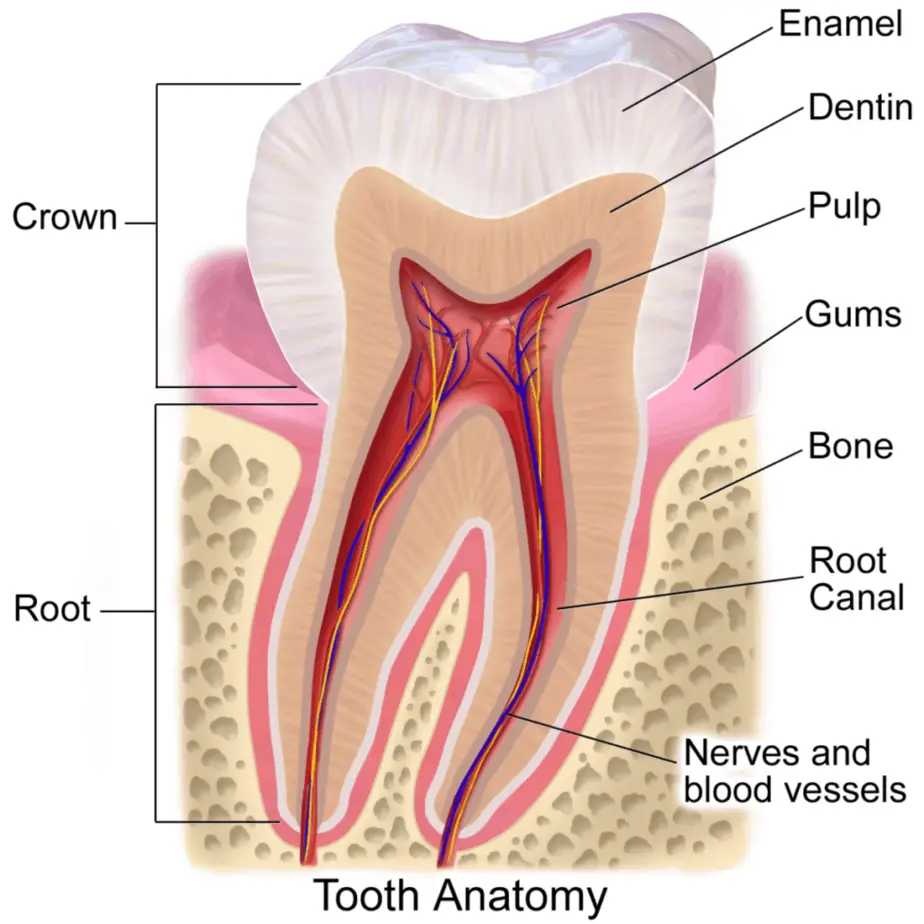
That short-lasting sharp pain occurs when the dentin is exposed and is stimulated.
What causes tooth sensitivity?
There are many reasons for a hypersensitive tooth nerve;
- Gum recession which is caused by;
- Clenching/grinding
- Gum disease (gingivitis and periodontitis)
- Brushing too hard/incorrect technique
- Also known as toothbrush abrasion
- Oral piercings (lip/tongue/cheek)
- Diet (sweet, spicy, acidic, hot/cold)
- When you have gum recession these things can stimulate the exposed nerve
- Broken and chipped teeth
- This can leave the soft dentin layer exposed
- Cavities
- This can leave the soft dentin layer exposed
- Infected/dying nerve
Understanding the cause of your sensitivity is the number one thing we need to address and get to the bottom of.
We don’t just want to cover up the pain you are feeling, we want to actually treat the problem, and figure out what we can do as a team to reduce your risk factors.
Talk with your dental professional about what you are experiencing.
The most common cause
Recession and the “pulling away” of the gum tissue from the tooth is the most common cause of tooth sensitivity. Often caused by gum disease, including both gingivitis and periodontitis (periodontitis is a chronic inflammatory infection that involves the loss of gum and bone tissue, ultimately resulting in tooth loss).
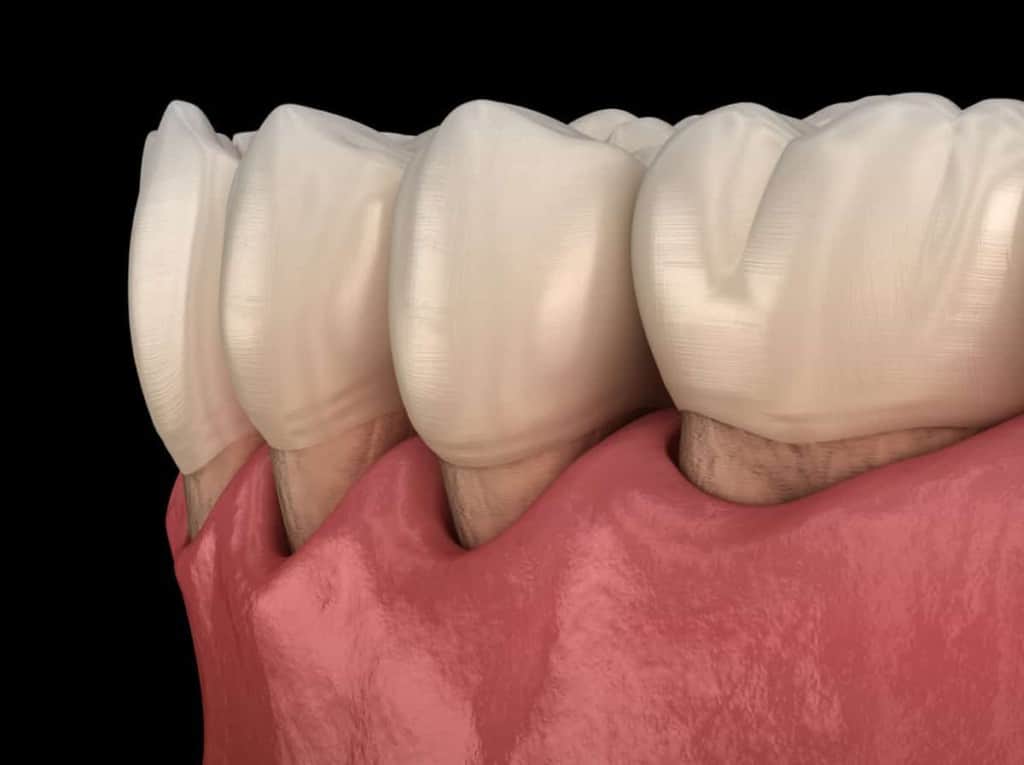
If you are experiencing gum disease, you should be working with your dental professional to come up with a game plan to treat it, to prevent further tissue loss, that can lead to more sensitivity.
But which sensitive toothpaste is right for you?
The type of sensitivity toothpaste that will work for you may vary depending on your diet, the current status of your mouth such as root exposure, gum disease, decay or if you are whitening your teeth.
The two main ways to reduce sensitivity is to either numb the nerve of the tooth so you don’t feel it or to block/cover the areas that are sensitive.
Below you can find the different kinds of toothpaste that Sensodyne has to offer and how they work and hopefully, you find the one that will work best for you!
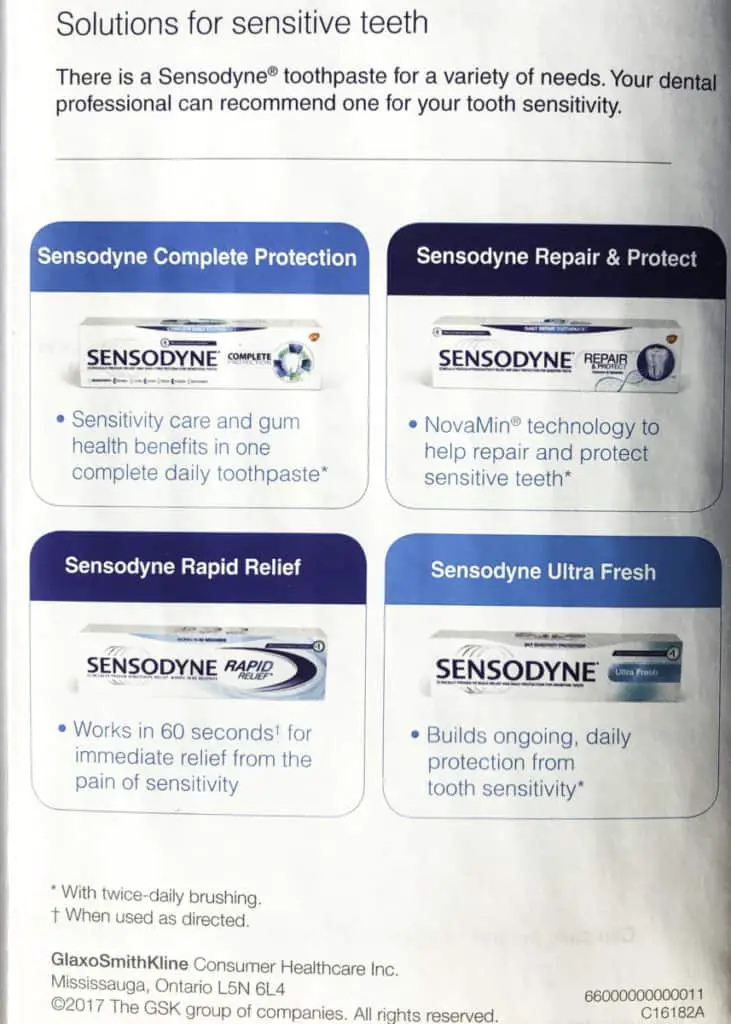
Sensodyne Original
Active ingredient: potassium nitrate
Perfect for: generalized sensitivity and root exposure


Potassium nitrate will make its way into the holes in the exposed dentin and work by de-polarizing the nerve endings inside the tooth.
This essentially causes the nerve to go numb so when you have something that used to cause you sensitivity, you won’t feel it. This prevents the signal of pain from being sent to your brain.
How long it takes to work; up to 2 weeks (you may have relief sooner than that)
Sensodyne Repair and Protect
Active ingredient: Novamin
Perfect for: generalized sensitivity and root exposure


This version uses Novamin technology which is a substance made up of calcium sodium phosphosilicate. This substance binds to the exposed dentin, plugging the holes and covering up the area.
The layer it forms is actually 50% harder than the root surface, protecting from wear caused by toothbrush abrasion and an acidic diet!
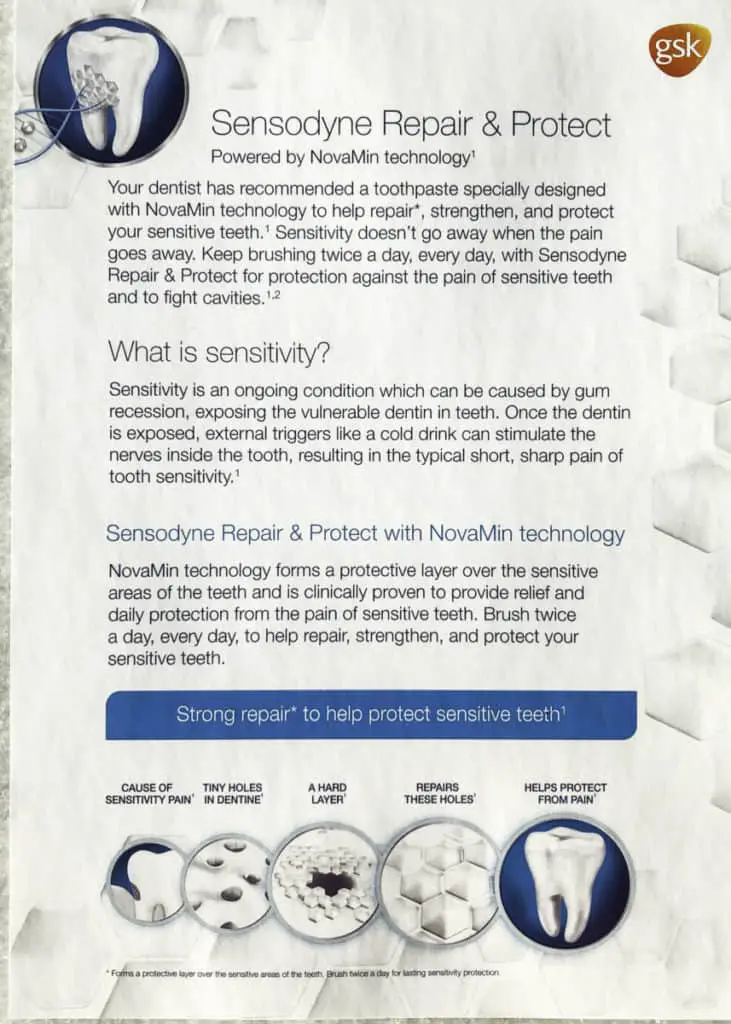
Even after you are done brushing (remember no rinsing your mouth out after using it, and no eating or drinking for at least 30 minutes) the toothpaste continues to work, laying down the layer of Novamin.
How long it takes to work; 2 weeks + and can keep improving up to 14 weeks
Sensodyne Rapid Relief
Active ingredient: stannous fluoride
Perfect for: acute sensitivity affecting a small area – could be 1-2 teeth and the pain can be quite intense


The first time you ever use this toothpaste you will want to put a little dab on your finger (about the size of a grain of rice/small pea) and you want to dab and rub it on the affected area for 60 seconds… yes, I said 60 seconds! You want to leave it on the teeth. Do NOT rinse your mouth out.
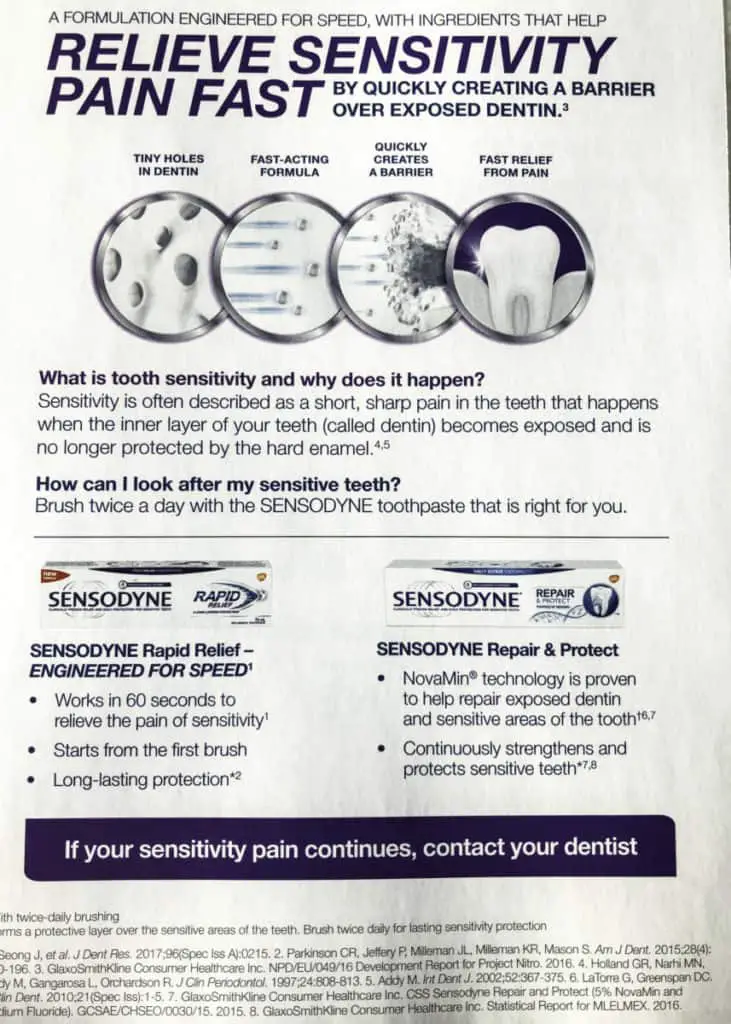
By dabbing and rubbing for 60 seconds, you are pushing the toothpaste into those microscopic holes on the root surface, plugging them.
How long it takes to work; immediate effect when dabbing but the full effect is achieved after 3 days
Sensodyne Complete
Active ingredient: stannous fluoride
Perfect for: generalized sensitivity and root exposure


Stannous fluoride is more effective than sodium fluoride. It has better antimicrobial properties, reducing the number of bacteria in your mouth and consequently reducing gingivitis. It also helps against tooth sensitivity.
You may be wondering; if it is that good then why isn’t it in every toothpaste?
The drawback is that it has tin in it and can stain your teeth, but Sensodyne puts a lifter in the toothpaste that actually binds to the tin so it doesn’t get absorbed into the teeth causing the stain.
Other brands of toothpaste that use stannous fluoride put a bleaching agent in the toothpaste to try and counteract staining from the tin. But this only does so much, and can still stain your teeth – the stain will just be a lighter colour.
How long it takes to work; 2 weeks
Sensodyne ProNamel
Perfect for: people who do not have gum recession/wear on teeth. For people who have an acidic diet.
ProNamel is more of a preventative toothpaste. It is for those people who know they have an acidic diet. This toothpaste won’t give you the results that Sensodyne’s original will.
The amount of potassium nitrate that is in ProNamel is not as much as in the Sensodyne original. So if you are not having success at reducing your sensitivity with ProNamel, try using the original Sensodyne instead.


Your diet is considered acidic if you consume more than 4 “acidic” foods/beverages a day. But let’s be honest, we all are!
How to use Sensodyne toothpaste
Using a tool properly is essential to how effective it can be. And using Sensodyne is no different.
You always want to clean in between your teeth before brushing. Flossing between your teeth removes most of the plaque (food debris and bacteria) from at least 35% of your tooth surface. This is an area that the toothbrush bristles have a hard time reaching, or may not reach at all!
Cleaning between the teeth allows the toothpaste to flow between the teeth letting the active ingredient in the toothpaste reach between the teeth and work its magic!
c
You never want to rinse your mouth out with water or eat or drink anything for at least 30 minutes after… just like the fluoride rinse treatment you may receive at the dental office.

When you rinse your mouth out you are rinsing away most of the active ingredients, making it much less effective.
I know this sounds obvious and us dental folk sound like a broken record, however, don’t forget to brush for at least 2 minutes twice a day.
The average time people brush for is around 40 seconds! Scary!
How your healthy diet can cause sensitivity!
We may be doing good to our bodies by eating healthy but that can have an opposite effect on our teeth. No need to change that healthy diet, you just want to have the best line of defence for your teeth!
Our healthy diets are very acidic, causing erosion of tooth structures. Things like coffee, salad dressing and fruit can start to dissolve and wear away at the teeth. When we start to wear away the outer layer of our teeth it can expose the dentin causing sensitivity.
When our mouth is in a state of acidity the teeth become softer and will absorb other pigments that can stain the teeth. Take red wine, for example, it is acidic and it will sink into the teeth causing staining. White wine is the same, it is even more acidic than red wine, softening the teeth, so anything you eat or drink with it, the pigment will cause tooth stain.
I have sensitive teeth but I want to whiten them!
Use the original Sensodyne with potassium nitrate for 2 weeks prior to whitening. This will numb the nerves of the teeth enough to prevent most of the sensitivity caused by whitening.
You can use a formulation of Crest Whitestrips that have a lower concentration of the whitener and you use over 14 days. It may take longer to get results, but at least the sensitivity will be reduced.
that have a lower concentration of the whitener and you use over 14 days. It may take longer to get results, but at least the sensitivity will be reduced.


Also, using an electric toothbrush will help keep stains at bay, but also be gentle on your gums to prevent gum recession.
My favourite electric toothbrush is the Oral-B , I just love that it comes with a pressure sensor to tell you when you are brushing too hard. It also lowers the power if you are brushing too hard, so it won’t be working as aggressively against the gum tissue and teeth.
, I just love that it comes with a pressure sensor to tell you when you are brushing too hard. It also lowers the power if you are brushing too hard, so it won’t be working as aggressively against the gum tissue and teeth.


Important notes
I do not represent Sensodyne in any way and they do not influence me to write about their products. I just love them and the products they make. They actually care about the consumer and genuinely want to help relieve them of tooth sensitivity and promote a healthy and happy smile!
If sensitivity symptoms last for more than a month after starting to use a sensitivity toothpaste, you may want to make an appointment to get it checked by your dentist. There could be an underlying reason for the sensitivity such as decay or an infection.
Sensodyne is like a medication that you would take for another medical condition.
A great example of this is blood pressure medications. If you have high blood pressure, and then start taking medication, your blood pressure will be reduced, however, if you stop taking the blood pressure medication, your blood pressure will rise again. Same with Sensodyne.
If you stop using it, over time the sensitivity will return.
Holly 🙂

